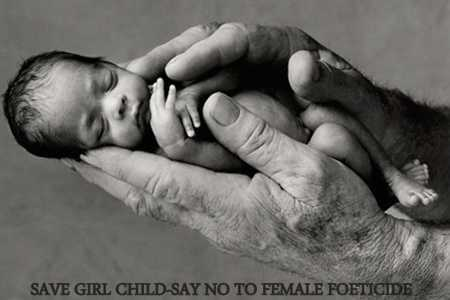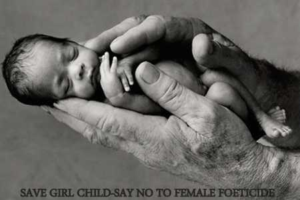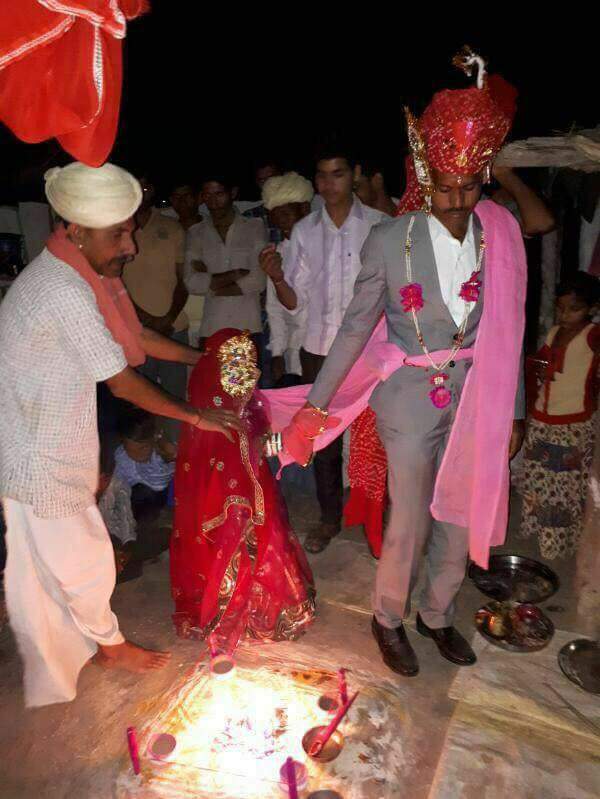Female Foeticide- The Bitter Truth

By Neer Mohammed
 Female foeticide is undoubtedly one of the most inhuman practices that plagues our society today. A lot has been said and written on this sensitive topic. The recent discussion on Aamir Khan’s show Satyamev Jayate has once again brought the issue to public attention.
Female foeticide is undoubtedly one of the most inhuman practices that plagues our society today. A lot has been said and written on this sensitive topic. The recent discussion on Aamir Khan’s show Satyamev Jayate has once again brought the issue to public attention.
In the discussions that followed the verse यत्र नार्यस्तु पूज्यन्ते रमन्ते तत्र देवता (Devatas reside where women are worshipped) was used repeatedly. This painted a misleading picture of the ancient indian society suggesting that misogyny sprung up from nowhere. A closer examination reveals, however, that this verse from Manu Smriti has been divorced from its context and the word “पूजन” or “पुजा” has been interpreted rather arbitrarily to suit a particular view. We reserve the discussion of this verse for future articles.
Earlier there were 40 accepted Vedic sanskar (sacraments), now however only 16 of these are conducted. The first of these 16 sanskar is that of “Garbahabhan” (conception), the second being “Punsavan”. Before coming to the main subject of the article, I would like to place before the reader a few facts about these sanskar (sacraments).
Varna System or Death System?
What follows is a brief analysis of these sanskar (sacraments) and the caste system. In Hinduism the evil of caste gets associated with the person from his birth itself. On the face of it Swami Dayanand and Arya Samaj seem to reject the birth based caste system and accept a social system based on merit but do they practice what they preach? To investigate this let us consider the following three verses from Manu Smriti. The first two of these occur as they are in Swami Dayanand’s Sanskar Vidhi published by Arya Sahitya Prachar Trust (Arya Samaj)

(A)”Garbhan and other Sanskar (sacrament) of dwija should be performed with holy rites prescribed by the Veda. Because these sanctify the body and purify in this life and after death” ( Manu Smriti 2-26)
(B)”By womb related sacraments (Garbhadan, Punswan, Simantyan), Jatkarma, Chudakarma and Upanyan sanskar (sacraments) the defects related to the womb and the semen of the Dwijas is removed” (Manu Smriti 2-27).
(C)“Let (the first part of) a Brahmana’s name (denote something) auspicious, a Kshatriya’s be connected with power, and a Vaisya’s with wealth, but a Sudra’s (express something) contemptible.
(The second part of) a Brahmana’s (name) shall be (a word) implying happiness, of a Kshatriya’s (a word) implying protection, of a Vaisya’s (a term) expressive of thriving, and of a Sudra’s (an expression) denoting service.” [Manu Smriti 2/31-32]
The third verse is not from the above mentioned book however the idea is mentioned in the book in following manner

“The male child born should be named thus – if the child is Brāhman – name him ‘Devsharmā’, if he is Kshatriya- name him ‘Devvarmā’, if he is Vaishya – name him ‘Devgūpta’,if he is a Shūdra name him ‘Devdās’.
Here it has been advised to name a child in the naming ceremony (10 days after birth) according to the above mentioned rules.
Whether such practices can remedy deficiencies of semen or womb is irrelevant but a number of questions arise after reading the above, why is this practice limited only to the Dwijas (Brahman, Kshatriya and Vaishya)? What is the basis of this distinction drawn between the Dwijas (referred to as ‘twice-born’ henceforth) on one hand and the Shudras on another? Certainly there is no difference in merit of 10 days old twice-born and Shudra, then why is a child born in Shudra family believed to be a ‘Shudra’ and has ‘das’ appended to his name? These people who keep insisting that Varna system is not based on birth but on merit have no answers to these questions.
Punsavan Sanskar (Sacrament)
What exactly is this Punsavan Sanskar (sacrament)? Pandit Shripad Damodar Satvelkar while explaining the ‘Punsavan’ sukta from Atharvaved, in his commentary of Atharvaved writes,
“The birth of son is called ‘Punsavan’ and birth of girl is called ‘Straishuya’”
Shri Damodar has named the section where he explains this sukta as “Certain birth of son” this in itself explains the term ‘Punsavan’. Swami Dayanand’s associate who later became the leader of Sanatan Dharma, Pandit Bhimsen Sharma while explaining the ‘Punsavan’ writes,
उत्पत्स्यमानगर्भस्य बेजिकगार्भिकदोषपरिहारार्न्थ पुंरूपत्वसंपत्तये च पुंसवनम्
(षोडशसंस्कारविधी, तृतीय संस्करण,1926, पृ. 72-73)
“Punsavan Sanskar (sacrament) is conducted to remove the semen and womb related deficiencies of the unborn child and to make it male”
In other words the sanskar (sacrament) is conducted so that a male child is born and if the unborn child is female then it should be transformed to a male child. This is the ancient Vedic way of getting rid of female foetuses. Even if we leave aside the question of effectiveness of such a procedure, the mentality operating behind such practices can be easily seen. If the female foetus itself is converted to male foetus then there is no question of birth of girls. This indicates that why even today people do not wish a girl child to be born to them.
While today, scientific methods are used to detect the sex of the foetus and to kill it if it is a girl, in Vedic times the foetus itself was transformed (at least people wished to do so) to a male foetus. The underlying mentality is same, only the methods have changed.
Swami Dayanand presents five proofs related to Punsavan Sanskar, without mentioning their meaning. However, the meanings given by other Arya Samaji Scholars make the picture clearer. Below is the meaning given by Ramgopal Vidyalankar in his book titled Sanskar-Prakash Arthart Mahrshi Dayanand Sarsvati Parnit Sanskarvidhi on pages 43-44
पुमानग्निः पुमानिन्द्र: पुमान्देवो ब्रहस्पति: पुमांसं पुत्रं विन्दस्व तं पुमाननु जायतां स्वाहा [मंत्रब्राह्मण 1/4/9]
“Agni, Indra, and learned scholar of diverse disciplines – give you strength. May you get a strong son and let even his descendent be strong.” [Mantra Brahman 1/4/9]
शमीमश्वत्थ आरूढ़स्तत्र पुंसवानं कृतम् तद्वै पुत्रस्य वेद्नं तत्स्त्रीष्वाभरामसि [अथर्ववेद 6/11/1]
“’Punsavan is done after a man as virile as a horse conceives a woman calm by nature as it is the best solution to get a son. The sanskar (sacrament) is conducted on women.” [Atharvaved 6/11/1]
Let me also mention the interpretation of Pandit Shripad Damodar Satvelekar
“(अश्व–त्थ: ) Peepal tree (शमी आरूढ़:) where it grows on Shami tree (तत्र पुंसवनं कृतं ) Punsavan is done there. (पुत्रस्य वेदनं) This ensures birth of a son (तत् स्त्रीषु आ भरामसि) we give this to women ”
Shri Damodar explains the procedure of this sanskar (sacrament) in his exegesis of this verse
“1. The Peepal tree that grows on the Shami tree makes the foetus in the womb take male form. That is if a woman takes the medicine prepared out of this then she will definitely give birth to a son. 2. Such a Peepal tree ensures the birth of a son. 3. The consumption of it ensures the birth of a son. 4. Women should be given the medicine prepared from such a Peepal tree to ensure the birth of a son.”
Shri Damodar continues
“The peepal tree growing on a Shami tree should be powdered and should be consumed with honey or milk etc. This makes the woman’s womb capable of producing a son. This medicine should be given to a woman who gives birth only to girls. This changes their womb and may generate strength to produce a male child.”
Now let us take a look at the second verse of ‘Punsavan’
Ramgopal Vidyalankar writes
पुंसी वै रेतो भवति तत् स्त्रियामनुषिच्यते तद् वै पुत्रस्य वेदनं तत्प्रजापतिरब्रवित् [अथर्ववेद 6/11/2]
“God Prajapati has said that semen definitely is in man, this is nurtured in the woman and thus a son produced.”
Shri Damodar explains this as
(पुंसी वे रेतः भवति)Semen definitely is in the man (तत् स्त्रियो अनु षिच्यते) it is nurtured in the women ( तद् वै पुत्रस्य वेदनं)it is a means to get a son,( तत् प्रजापतिः अब्रवित् ) this is said by Prajapati .
Let us turn to the 3rd verse.
Ramgopal Vidyalankar –
प्रजापतिरनुमतिः सिनीवाल्यचीक्लृपत् स्त्रैषूमन्यत्र दधत्पुमांसमु दधदिह [अथर्ववेद 6/11/3]
“Prajapati, Anumati and Siniwali (Sanvatsar, Pournima and Amavasya) complete the foetus. The rules concerning the birth of female are mentioned elsewhere, the rules related to male are described here.”
Shri Damodar writes –
“(प्रजापतिः अनुमतिः) Father should be determined to get a son (सिनी–वाली अचीक्लृपत्) and the mother should be capable (of bearing a son) only if this happens (पुमांसं उ इह दधत्) a male foetus is formed (अन्यत्र स्त्रैषूयं दधत्) otherwise a female foetus is formed..”
Whatever has been said about this third verse of ‘Punsavan’ sukta of Atharvaved is quite clear except the second part which can have three meanings
The first and second are given these scholars
- The rules concerning the birth of female are mentioned elsewhere the rules related to men are described here.
This interpretation could have been accepted if the rules concerning the birth of females had been mentioned in the Vedas elsewhere but we have to say with great disappointment that perhaps this is not true. For this reason this interpretation is unacceptable. However, even with this interpretation the importance given to the birth of a son can be clearly seen.
- Male foetus is formed (in the conditions mentioned above) otherwise a female foetus is formed.
This interpretation given by Shri Damodar is accepted but the implications of such an interpretation are noteworthy. If this interpretation is true then definitely birth of a son would be wished for since ‘Punsavan’ is performed by everyone.
- Third interpretation would be – Let girl/female foetus be placed in some other womb and male fetus be placed in this womb. Even this meaning exposes the underlying mentality which wishes for a male child and rejects a female child.
So, these are the verses used to prevent a female child from taking birth and ensuring the birth a male child. It would not be wrong to call this the ancient and Vedic version of female foeticide. The Hindu scriptures enjoining ‘Punsavan’ fail to even mention the sanskar (sacrament) named “Straisuy”
As far as Vedas are concerned women are not allowed to give birth to a female child, there however, is the command to give birth to 10 sons. A verse from Rigveda reads
इमां तवमिन्द्र मीढ्वः सुपुत्रां सुभगां कर्णु । दशास्यां पुत्राना धेहि पतिमेकादशं कर्धि || -ऋग्वेद 10/85/45
Swami Dayanand writes the meaning of this verse as follows
O majestic man capable of nurturing semen! Give a married woman or widow the best son and grant her good fortune. Produce 10 sons for a married woman and consider the 11th to be a woman.
This makes it clear that the birth of a girl is neither desired nor considered good since ancient times. However such verses can neither change the way sex is determined nor can they prevent the birth of a girl child. As such a girl once born has to be accepted. But nothing changes after this
In the ‘Harish-Narad dialogue’ in Aitreya Brahman which is an explanation of the Rigved, Narad says:
कृपणं ह दुहिता
“Daughter leads to suffering and is a cause of misery”
While explaining this, scholar Sayancharya quotes an ancient verse
संभवे स्वजनदुः खकारिका संप्रदानसमयेर्थदारिका योवनेपि बहुदोषकारिका दारिका ह्रदयदारिका पितुः
“When a girl is born, she makes relatives unhappy; when she gets married she takes away wealth. She commits a lot of mistakes in her youth that is why it is said that she cleaves her father’s heart”
Yaska Acharya writes with respect to ‘daughter’ in his Nirukt
“Daughter is called Duhita because she is Durhita (one who does bad) and Durehita (it is better if she stays far away). She is Dogdha (one who sucks parent’s wealth)” – (Nirukt Adhayay 3, Khand 4)
In the next Adhyay of the same book, while explaining the word ‘Kanya’ Acharya Yaska writes,
क्वेयं नेत्व्य
(Nirukt Adhyay 4 Khand 15)
“Kanya is so called because as soon as she takes birth parents start worrying about her marriage”
These examples show the negative view associated with the birth of girl in Hindu culture and Hindu religious scriptures. It is this mentality which is criticized in the Qur’an in the following words –
And when one of them is informed of [the birth of] a female, his face becomes dark, and he suppresses grief. He hides himself from the people because of the ill of which he has been informed. Should he keep it in humiliation or bury it in the ground? Unquestionably, evil is what they decide. (Qur’an 16/58-59)
Allah, the Exalted puts an end to the discrimination between a boy and a girl in the Qur’an
To Allah belongs the dominion of the heavens and the earth; He creates what he wills. He gives to whom He wills female [children], and He gives to whom He wills males. (Qur’an 42/49)
A point worth noting is that in this verse daughters are mentioned before sons. Commenting on this verse Sayyidina Wathilah ibn Aska said, fortunate is the woman who has a daughter as her first child.
Prophet Muhammad (peace and blessings of Allah be upon him) said,
If anyone has a female child, and does not bury her alive, or slight her, or prefer his sons to her, Allah will bring him into Paradise. [Narrated by Abdullah ibn Abbas; Abu Dawud, Kitaab al-Adab, Hadith 5127)
To conclude, I would like to say that to put an end to the evil practice of female foeticide and the negative view associated with a girl child, the mentality operating behind these needs to be destroyed. How do we do that? Well,
किं ग्राहृयमग्राहृयमिति कवयो नात्र मोहिताः, अज्ञस्तु मूढ़मतित्वात्सतृणमभ्यवहारी ।।
Deciding between the acceptable and unacceptable is not difficult. A wise person embraces the acceptable and rejects the unacceptable but a foolish person due to his foolishness believes a cow and donkey to be the same.

